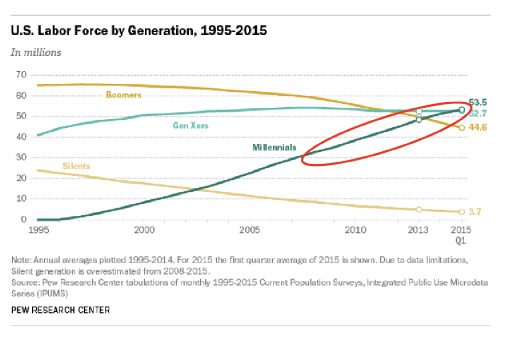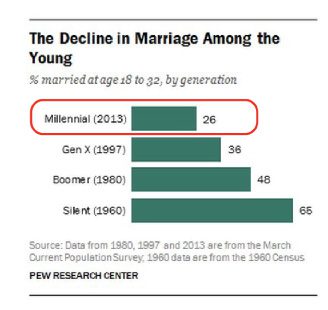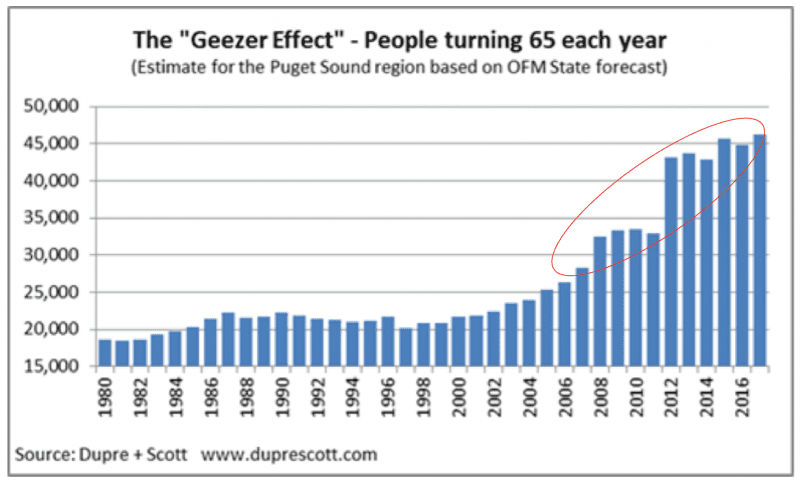It doesn’t take more than a long evening in South Lake Union’s traffic to know that Seattle has changed a lot in the last decade. I’ve written about many of the drivers of this change – from Amazon’s growth to the resulting tech flywheel effect, and the influx of high-wage talent, etc. But there are bigger demographic forces at work, too, that savvy investors need to heed.
Employment is a major factor driving demand in Seattle, but another factor that influences where renters are settling down and how they live is their generation. New trends emerging nationally are having an impact in our own backyard.
Millennials
Millennials are the largest living generation
In 2016, Millennials (people born between 1981 and 1997) surpassed Baby Boomers as the world’s largest living generation, and they already make up a majority of the American workforce. As this generation continues to age into adulthood, their impact on the local and national economy is immense.

Millennials make up 15% of Seattle’s population, and this percentage will only grow as big tech companies attract more recent college graduates. Seattle is also in the top 5 cities for our concentration of “superrich” Millennials, a title given to those who make more than $350,000 a year. All told, Seattle is gaining a literal wealth of high-income Millennials who will shape the next decade of demand for apartments.
Developers are already adjusting what they offer in new apartments, from high-end gyms to chicken coops and lawn games. Investors are changing how they market apartments, too – they pitch buildings as part of a lifestyle that renters can enjoy, and they sell on proximity to bars, restaurants, and parks.
Like it or not, the whims of this growing generation will be a big driver in the rental market for a long time to come. Millennials are moving to Seattle faster than developers can build, and they’re ready to rent based on lifestyle and amenities.
Millennials are getting married later and starting families later
According to a recent study from the National Multifamily Housing Council, demand for new apartments has increased dramatically over the past five years, and part of this pressing demand comes from people delaying the major life events – marriage, children – that usually prompt homebuying.

Instead, all these people – and most are Millennials – are renting instead. Many prefer to live with their partners for several years before tying the knot, and even after marriage they spend several years in apartments before turning to homebuying. And if you’re living in Seattle, bad news – even after you’re ready to buy a home, you face the nation’s toughest housing market.

The result? By choice and (sometimes) by necessity, residents are staying in the rental market longer than ever before. The results of having a new generation of long-term renters is unclear so far, but older, long-term renters may be more likely to pay higher rents, and their demands for an apartment could shift.
Generation X
Generation X hit hardest by Great Recession
This generation should be the biggest cohort buying homes right now in Seattle, but they were also the generation hit hardest by the crash in 2008. While some undoubtedly are buying right now – those big ticket prices are coming from somewhere, after all – many choose to stay in the rental market while they get their heads above water and their credit scores out of the red.

Many renters in Generation X will be looking for rental options that can fit their family lifestyle, which means higher demand for 2+ bedroom units, or apartments in traditionally residential neighborhoods like West Seattle and Greenwood. These residents are also more likely to be short-term renters, especially if the housing market cools.
This generation is smaller than the ones before it and after it, but they are in the prime homebuying period, and the fact that many are opting out will have long term implications for Seattle’s housing market as well as the multifamily market.
Baby Boomers
Baby Boomers are downsizing… and renting
Millennials aren’t the only cohort with their eyes on Seattle’s new spate of luxury high-rise apartments downtown. Baby Boomers are expected to account for about 20% of America’s renting population by 2020, and as neighborhoods like Downtown, Belltown, and South Lake Union receive an influx of new, high-end product, Baby Boomers can downsize without sacrificing their lifestyle.
Some Baby Boomers choose to move – and rent – in order to be closer to their friends or family, while others simply acknowledge that they don’t need as much space as they used to. No matter the reason, these Boomers want to live within walking distance of a grocery store, shops, and activities.

In Seattle, this trend indicates that demand could stay strong for smaller units in newer product in Seattle’s core, including more residential neighborhoods. This renter is able to pay higher rents for the location and lifestyle they want.
These generational trends will influence the shape of Seattle’s apartment market for the next few decades, and it’s important to understand how different demands from different generations could affect short-term and long-term rent and vacancy trends. As always, staying engaged in this market matters more than ever. Pick up the phone and call us (or shoot us an email) with any questions about the market. Contact us to Turn Our Expertise into your Profit!

